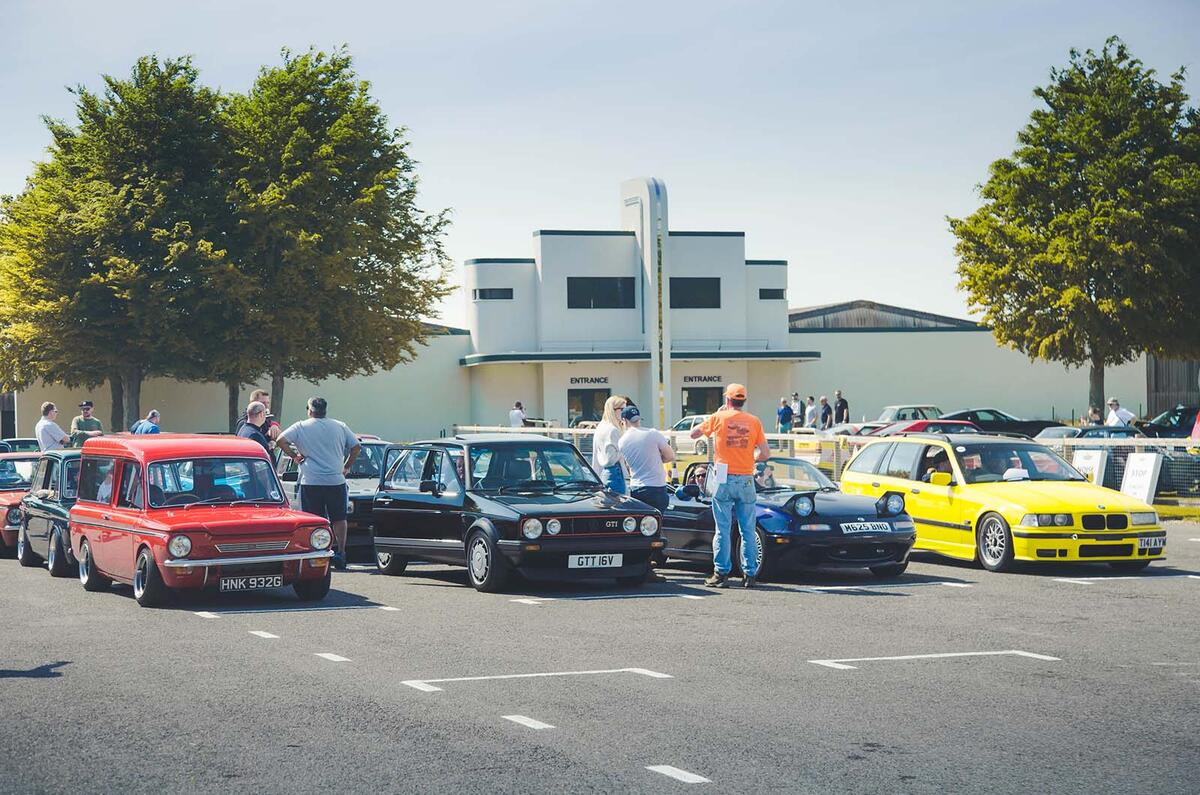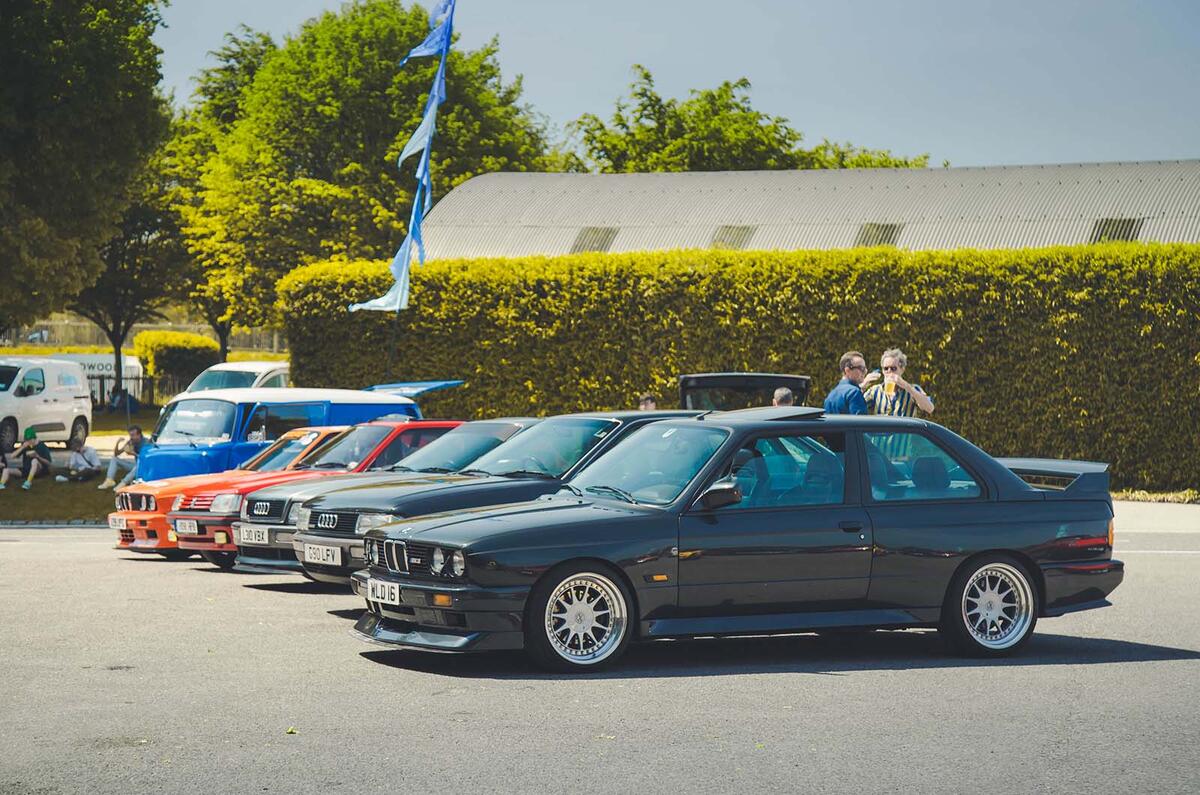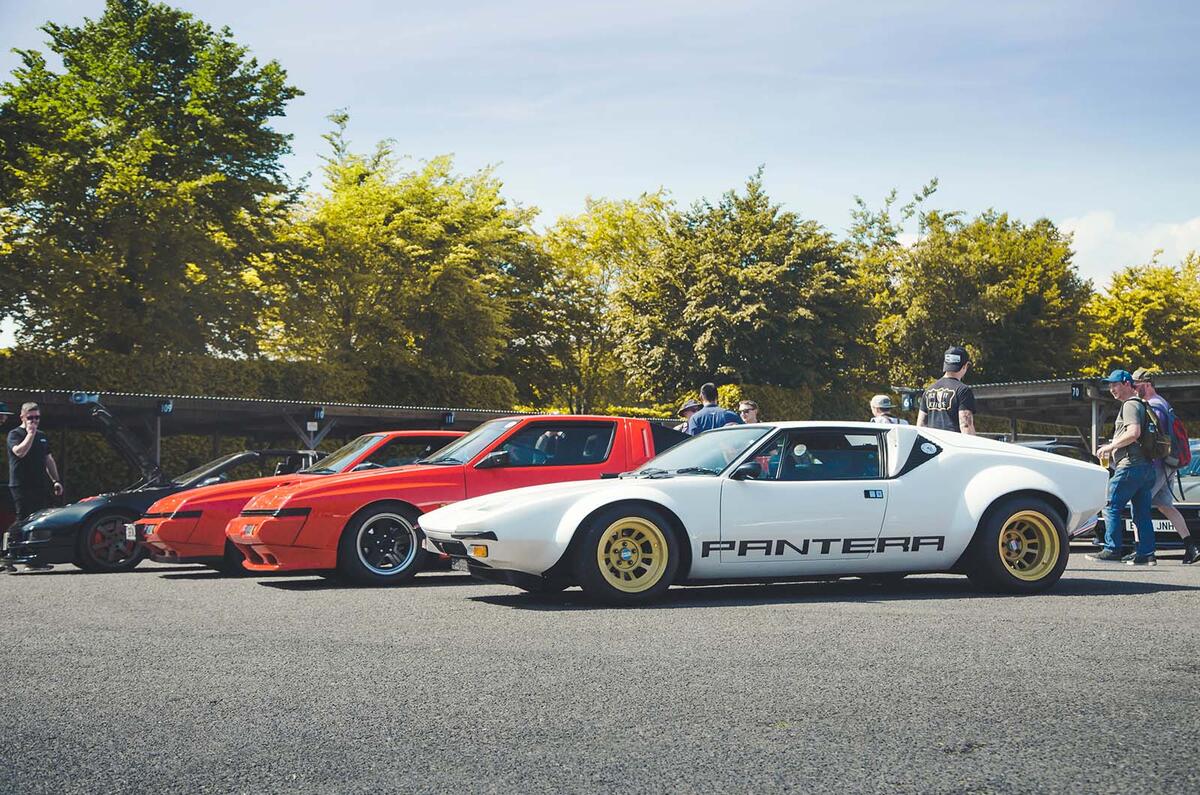Buttonless key. Ignition barrel. Turn once. Turn again. Turn a third time. A screeching fanbelt whines before a multi-cylinder roar takes over then settles to a lumpy idle.
What has just been described encapsulates the whole premise of Retro Rides – and the experience reflects ours when we took a top-spec Volvo 850 T5-R along to the event as our show car.
Retro Rides is a festival whose sole purpose is to allow car nuts to scratch a nostalgic, modern-classic itch. Hundreds of like-minded souls gather at Goodwood Motor Circuit and other venues up and down the country to celebrate the simple joys of motoring without the modern-day beeps and bongs or the intrusion of lane keeping assistance.
I say ‘modern classic’ because, unlike many other festivals on the motoring circuit, this one deals with a huge array of vehicles: think Chevrolet lowrider, a Datsun 240Z with an outrageous engine swap, a Volvo limousine with half of another Volvo attached to the back of it and something not unlike Mr Bean's Mini.
There is, of course, the obligatory cacophony of Mk2 Volkswagen Golfs and supercharged Ford Fiestas, but each is a celebration of carburettors, worn-out ignition barrels and halogen headlights – and the owners and festival-goers simply can’t get enough of it.
Here, then, is a collection of our favourite cars and the stories behind them, each one more retro than the last.
What is Retro Rides?

Simply speaking, Retro Rides is a laid-back, anything-goes celebration of retro car culture that's open to all models registered before 2000, and it has quickly become one of the UK's most eagerly anticipated classic car events.
Retro Rides was founded in 2004 as an online forum (which now has more than 50,000 users) before transitioning to an in-person event, the first of which was held at Mallory Park in 2007. Since then it has become as much a celebration of DIY engineering as one of aesthetics.
The format changes every year, with 2024 including celebrations of the Volkswagen Golf GTI, pop-up headlights, black-coloured cars and lowriders. It’s small wonder that thousands of people are attracted to each of the two annual events – and that number is growing every year.
Volvo 850 T5-R

It would be silly to not mention the car that made this feature happen: this 850 T5-R arrived at the Autocar office from Volvo's heritage fleet both as our transport to Retro Rides and as something to show our support for the five-cylinder family estate with a turbocharger the size of Latvia.
Under the bonnet sits a 2.5-litre five-pot that produces 236bhp, sends the 1468kg estate to 62mph from rest in 6.6sec and on to a top speed of 155mph. Not that you'd necessarily be especially keen to go that fast, given that the car is now nearly 20 years old. But if you wanted to, and if you had the space to do it, this T5-R would be more than up to the job.

What strikes us are the smoothness of its power delivery and the way its yellow paint is so well suited to its image of left-field estate that is still, for reasons that are difficult to explain, compelling. When we parked it at the show, its breeze-block shape and traditional 1990s Volvo styling cues were a source of endless appeal to fellow motorists and festival-goers, with many commenting on how much they would like one but were unable to find one in such immaculate condition.
Its relative narrowness compared with modern cars also stood out, and it goes some way towards explaining the appeal of these retro machines. They're neither modern nor technically impressive, and they’re not even desperately pretty. But that is exactly why their enthusiast appeal endures.
Audi 80 Avant diesel

This Audi has had, and continues to have, quite a life. From the moment it was bought at an auction for £900 20 years ago and then immediately broke down, to five years later when its current owner, Martin Tiffin, began a £15,000 journey of turning it into one of the most reliable cars he has ever owned.
It became a classic love affair. A car that he originally bought to ferry flotsam to the dump and help him with a building project ended up becoming a machine that he sleeps in and has framed pictures of, and which represents, in his words, "the last era of car that you have to really drive". Its 1.9-litre engine has done more than 300,000 miles without fault, despite the fact that for the first seven years he didn’t service it.
So besotted with this car is the owner that, when asked if he would sell it for something ULEZ-compliant, Tiffin replied: "I'd just convert it to electric."
BMW 840Ci

A total of £30,000 has been lavished on this car by devoted owner Lukas Wagel, who has had an affinity with the E31 BMW 8 Series since he first saw one on a seaside holiday during his childhood.
His car, an Individual-spec 840Ci, is almost completely new underneath, with a new engine, new suspension, refurbished alloys and near-perfect rubber seals that on their own cost thousands of pounds. The refurbished 8 was about two years in the making (and seven months’ waiting for parts), and selling it would never cross Wagel's mind.
Supercharged Mini Mayfair

What was once an "absolute rot-box" (owner's words) is now a supercharged, 130bhp sub-tonne rocket with all the luxuries you'd expect of a Mayfair. When it was found in a less than favourable condition it had holes in some panels, rust in others and both in most, but every piece has since been replaced or repaired.
And the changes aren't just skin-deep. The front and rear subframes have been rebuilt and powder-coated, and four-piston brakes are fitted at the front. The engine has been bored out from 1275cc to 1293cc, with a high-lift camshaft upping the power and redline, along with forged pushrods and a supercharger. This means it now sends 130bhp and 125lb ft to the front wheels, which is a fair old helping in a car that weighs, according to its owner, around 700kg.
Lancia Flavia

This Lancia Flavia was found by the owner as a non-runner on eBay, after it had been sitting neglected for years with its engine distinctly absent. Among other issues its paintwork was in disarray, having been resprayed at least six times over its 51-year life.
But the owner, who has had maybe 10 Beta coupés, three Monte Carlos, two Spiders and one Flavia prior to this one, knows Lancias like he knows his dog. So he understood how to make it shine again, giving it a thorough respray in the original colour and an equally thorough interior deep clean.
And while Flavias of this era were fitted with a 1.5-litre flat four, this example has been treated to the larger 91bhp 1.8-litre unit used in cars from 1965 onwards. That’s thanks to the previous owner selling it with both engines as part of the deal.
Fiat Uno Turbo IE

This Fiat's keeper fell in love with the Uno Turbo IE at an early age. From his time as an apprentice working with Fiat and getting to drive one, to the moment he owned his first example at the age of 19, the Uno Turbo IE has always been a datum point.
It makes sense, then, for this one to be in such an immaculate condition. It has spent most of its life with the AA, where it accumulated just 270 miles before being bought by its previous owner, who took it on hill climb events.
Now, though, and after three years of painstaking detailing, it has been carefully restored to its original condition, with every serviceable item changed, new 14in alloys and a totally original 1.3-litre petrol engine that sends 118bhp to the front wheels – that’s as much as today's Volkswagen Up GTI.
Ford Escort AA van

This is one AA van that’s not about to come and rescue you from the side of the motorway; instead, it's a very good – and road-legal – impression of the real thing, thanks to a respray in 'Audi Vegas' yellow and some original decals.
At its core this is a 1990 Mk4 Ford Escort made to look like a Mk3, sharing its front and rear bumpers and its dashboard. The bumpers themselves and front splitter are carbonfibre, and the front wings have been chopped off for a cleaner and more streamlined look.
It's powered by the same 1.9-litre diesel engine from the Skoda Fabia VRS, codenamed PD130 and known to be one of the most bulletproof engines ever made. Interestingly, the owner found that a Ford engine cover fitted perfectly over the block, making it look even more authentic. A set of 16in steelies finish it off, giving the van a workaday look.
Porsche 944 S2

This 944 isn't upgraded. It doesn't have the V10 from an E60 BMW M5 hiding under its undisturbed bonnet, or a secret nitrogen booster or coilovers from Bilstein; it doesn't even have a custom exhaust. But I suspect the owner's aim was not to upgrade but to restore the car – to the point that it’s now cleaner than it was when it left the factory.
Its split-piece alloys glisten in the sun, its millpond-smooth bodywork is without so much as a scuff and the exhaust tailpipe shows not even a trace of soot. Not that it would, because the 208bhp 3.0-litre four-cylinder engine would most likely have been as clean on the inside as the whole car is on the outside.
Opel Monza GSE

Like the Porsche we saw earlier, this Monza has been restored to such a high standard that there is no visible evidence that it has ever been used for daily running. Powered by the same 3.0-litre straight six engine used in the Carlton GSi and designed to compete with the Mercedes C123 and BMW 6 Series, the Monza was produced between 1977 and 1982.
This one has MacPherson struts up front, with 18in alloys and a colour scheme that, we think, lends itself nicely to its blocky, Ford Sierra-like shape. This example hails from April 1982, making it one of the last pre-facelift cars to leave the production line.
Volkswagen Karmann Ghia

Walk up to this second-generation Type 34 Karmann Ghia and you would never guess that it was the fastest production Volkswagen of its time, with a top speed of 85mph. Instead, you might concentrate on its admittedly beautiful proportions, its 'Cherry Red' paint that glistens in the afternoon sun and the aggressive louvres at the rear feeding the 45bhp 1493cc flat-four Beetle engine.
Designed by Italian engineer Sergio Sartorelli and inspired by the Chrysler D'Elegance, the Karmann Ghia was built between 1961 and 1969 (this one's from 1964) as a more stylish take on its populist range-mate. This one was first UK-registered in 2020, suggesting it’s an import.
Chevrolet lowrider

A hopping, skipping and jumping Chevrolet was always going to make this list. Underneath it's pretty much standard, with most of the upgrades concentrated on making the chassis strong enough to deal with nearly three tonnes of bouncing American metal. So it has 6mm-thick steel bracings, a custom-engraved dashboard brought over from the US and no rear shock absorbers; instead the rear is supported by a simple torsion bar to make it as bouncy as possible.
Despite the extra bracing and torsional improvements, this Impala hasn't been without its faults: it snapped at last year's Classic Motor Show in Birmingham, pulling the steering column out of its mountings. Small wonder though, considering that it weighs 2.7 tonnes.
Audi S4 Avant

It might look like just an ordinary Audi S4 Avant, but beneath a staid, silver and essentially stock body sits a rival to the current BMW M3. This S4 might have the same 2.7-litre twin-turbocharged V6 as the standard car, but it features turbos from the RS6, Bilstein dampers, Brembo brakes with Porsche calipers, an uprated intercooler and fuel pump and a Milltek exhaust.
The engine itself has also been mapped, the upshot of which is a total power figure around 530bhp. That cliché about judging books by their cover springs to mind.
Mercedes E36 AMG

There's a distinctly Mafioso aura about this E36 AMG coupé, with its all-black paint, cream leather and blocky, flat-faced alloys. It's based on the 320TE but makes use of AMG's M104 3.6-litre straight six, which sends 272bhp and 284lb ft to the rear wheels via a four-speed torque converter automatic.
This car hails from 1995 and is one of four C124's registered in the UK. We picked it out purely because it comes from an era of AMGs when no engine was too big, there were no accountants in the way and the premise of any given model was to allow its owner to quietly(ish) demonstrate their good taste in cars.
This is evidenced by small details such as the AMG badge on the splitter, the aluminium pedals, the subtly flared wheel arches, four-piston brakes taken from the R129 SL500 and the ‘come and have a go if you think you’re hard enough’ bumper extensions.

















Join the debate
Add your comment
Some great cars puctured, especially that pantera.
I've been to many car gatherings like this. The most instructive part of the experience is to find a chair and watch all the old cars leave at the end of the day. It's when you smell the choking exhaust fumes caused by these old vehicles, plus the amount of unburnt petrol coming out of them because of inefficient fueling, that you realise the enormous pollution caused by old engines. Of course the pollution is even worse with old diesel motors. It's an enormous disappointment.